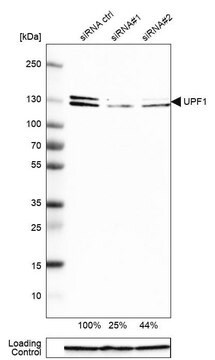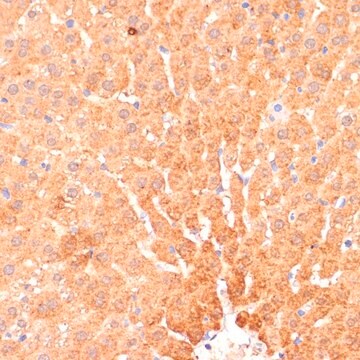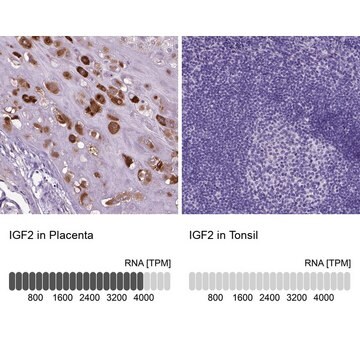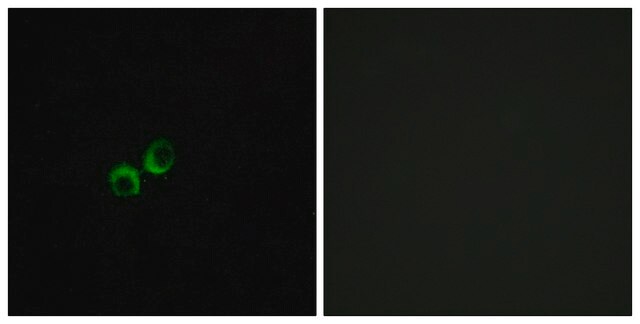HPA020857
Anti-UPF1 antibody produced in rabbit
Prestige Antibodies® Powered by Atlas Antibodies, affinity isolated antibody, buffered aqueous glycerol solution, Ab2
别名:
Anti-ATP-dependent helicase RENT1, Anti-NORF1, Anti-Nonsense mRNA reducing factor 1, Anti-Regulator of nonsense transcripts 1, Anti-Up-frameshift suppressor 1 homolog, Anti-hUpf1
登录查看公司和协议定价
所有图片(4)
About This Item
推荐产品
生物源
rabbit
共軛
unconjugated
抗體表格
affinity isolated antibody
抗體產品種類
primary antibodies
無性繁殖
polyclonal
產品線
Prestige Antibodies® Powered by Atlas Antibodies
形狀
buffered aqueous glycerol solution
物種活性
human
技術
immunohistochemistry: 1:20- 1:50
免疫原序列
KVPDNYGDEIAIELRSSVGAPVEVTHNFQVDFVWKSTSFDRMQSALKTFAVDETSVSGYIYHKLLGHEVEDVIIKCQLPKRFTAQGLPDLNHSQVYAVKTVLQRPLS
UniProt登錄號
運輸包裝
wet ice
儲存溫度
−20°C
目標翻譯後修改
unmodified
基因資訊
human ... UPF1(5976)
一般說明
The gene UPF1 (up-frameshift suppressor 1 homolog) is mapped to human chromosome 19p13.11. It belongs to the helicase superfamily 1. The protein localizes in the cytoplasm.
免疫原
Regulator of nonsense transcripts 1 recombinant protein epitope signature tag (PrEST)
應用
All Prestige Antibodies Powered by Atlas Antibodies are developed and validated by the Human Protein Atlas (HPA) project and as a result, are supported by the most extensive characterization in the industry.
The Human Protein Atlas project can be subdivided into three efforts: Human Tissue Atlas, Cancer Atlas, and Human Cell Atlas. The antibodies that have been generated in support of the Tissue and Cancer Atlas projects have been tested by immunohistochemistry against hundreds of normal and disease tissues and through the recent efforts of the Human Cell Atlas project, many have been characterized by immunofluorescence to map the human proteome not only at the tissue level but now at the subcellular level. These images and the collection of this vast data set can be viewed on the Human Protein Atlas (HPA) site by clicking on the Image Gallery link. We also provide Prestige Antibodies® protocols and other useful information.
The Human Protein Atlas project can be subdivided into three efforts: Human Tissue Atlas, Cancer Atlas, and Human Cell Atlas. The antibodies that have been generated in support of the Tissue and Cancer Atlas projects have been tested by immunohistochemistry against hundreds of normal and disease tissues and through the recent efforts of the Human Cell Atlas project, many have been characterized by immunofluorescence to map the human proteome not only at the tissue level but now at the subcellular level. These images and the collection of this vast data set can be viewed on the Human Protein Atlas (HPA) site by clicking on the Image Gallery link. We also provide Prestige Antibodies® protocols and other useful information.
生化/生理作用
UPF1 (up-frameshift suppressor 1 homolog) regulates nonsense-mediated mRNA decay pathway and translation termination. It plays crucial role in degradation of histone mRNAs. Mutations in UPF1 are associated with pancreatic adenosquamous carcinoma.
特點和優勢
Prestige Antibodies® are highly characterized and extensively validated antibodies with the added benefit of all available characterization data for each target being accessible via the Human Protein Atlas portal linked just below the product name at the top of this page. The uniqueness and low cross-reactivity of the Prestige Antibodies® to other proteins are due to a thorough selection of antigen regions, affinity purification, and stringent selection. Prestige antigen controls are available for every corresponding Prestige Antibody and can be found in the linkage section.
Every Prestige Antibody is tested in the following ways:
Every Prestige Antibody is tested in the following ways:
- IHC tissue array of 44 normal human tissues and 20 of the most common cancer type tissues.
- Protein array of 364 human recombinant protein fragments.
聯結
Corresponding Antigen APREST73937
外觀
Solution in phosphate-buffered saline, pH 7.2, containing 40% glycerol and 0.02% sodium azide
法律資訊
Prestige Antibodies is a registered trademark of Merck KGaA, Darmstadt, Germany
免責聲明
Unless otherwise stated in our catalog or other company documentation accompanying the product(s), our products are intended for research use only and are not to be used for any other purpose, which includes but is not limited to, unauthorized commercial uses, in vitro diagnostic uses, ex vivo or in vivo therapeutic uses or any type of consumption or application to humans or animals.
未找到合适的产品?
试试我们的产品选型工具.
儲存類別代碼
10 - Combustible liquids
水污染物質分類(WGK)
WGK 1
閃點(°F)
Not applicable
閃點(°C)
Not applicable
Handan Kaygun et al.
Nature structural & molecular biology, 12(9), 794-800 (2005-08-09)
Eukaryotic cells coordinately regulate histone and DNA synthesis. In mammalian cells, most of the regulation of histone synthesis occurs post-transcriptionally by regulating the concentrations of histone mRNA. As cells enter S phase, histone mRNA levels increase, and at the end
Chen Liu et al.
Nature medicine, 20(6), 596-598 (2014-05-27)
Pancreatic adenosquamous carcinoma (ASC) is an enigmatic and aggressive tumor that has a worse prognosis and higher metastatic potential than its adenocarcinoma counterpart. Here we report that ASC tumors frequently harbor somatically acquired mutations in the UPF1 gene, which encodes
Tobias M Franks et al.
Cell, 143(6), 938-950 (2010-12-15)
Cellular mRNAs exist in messenger ribonucleoprotein (mRNP) complexes, which undergo transitions during the lifetime of the mRNAs and direct posttranscriptional gene regulation. A final posttranscriptional step in gene expression is the turnover of the mRNP, which involves degradation of the
J Lykke-Andersen et al.
Cell, 103(7), 1121-1131 (2001-02-13)
Nonsense-mediated decay (NMD) rids eukaryotic cells of aberrant mRNAs containing premature termination codons. These are discriminated from true termination codons by downstream cis-elements, such as exon-exon junctions. We describe three novel human proteins involved in NMD, hUpf2, hUpf3a, and hUpf3b.
Thomas E Mullen et al.
Genes & development, 22(1), 50-65 (2008-01-04)
Histone mRNAs are rapidly degraded at the end of S phase or when DNA replication is inhibited. Histone mRNAs end in a conserved stem-loop rather than a poly(A) tail. Degradation of histone mRNAs requires the stem-loop sequence, which binds the
我们的科学家团队拥有各种研究领域经验,包括生命科学、材料科学、化学合成、色谱、分析及许多其他领域.
联系技术服务部门








